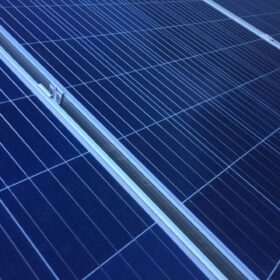Powering the AI revolution
Developers from the renewable energy and data center markets are working to find common ground to meet surging energy demand fueled by the artificial intelligence boom.
‘Without energy storage, renewables are not serious power plants’
Chinese inverter and energy storage maker Sungrow invited 300 guests from 20 European countries to its ESS [energy storage system] Experience Day event in Munich, Germany. Discussions focused on energy storage, projects, market figures, and the energy transition. The conclusion: More storage and grid expansion are needed.
Fraunhofer showcases hydrogen microgrid platform
The Fraunhofer Institute for Machine Tools and Forming Technology IWU will showcase a new hydrogen microgrid platform at the end of March. The researchers say it could help to serve hospitals, remote rural areas and war-torn regions.
Key takeaways from Solar Solutions Amsterdam 2025
The Solar Solutions Amsterdam 2025 trade show highlighted the shift in Europe toward smarter, scalable energy systems, showcasing innovations in residential and commercial solar technology as demand for integrated, flexible solutions continues to grow.
China scraps energy storage mandate for renewable energy plants
In a major policy shift toward electricity market liberalization, China has introduced contract-for-difference (CfD) auctions for renewable plants and removed the energy storage mandate, which has driven up to 75% of national demand to date. S&P Global expects the move to reverberate through the global battery storage supply chain, further driving down prices already at historic lows.
UK T-4 auction clears path for nearly 7 GW of new battery storage by 2028
Out of 6.9 GW of prequalified battery energy storage systems (BESS), equal to 1.9 GW derated capacity, about 1.8 GW of derated BESS secured 15-year contracts in the UK’s T-4 auction – nearly double last year’s volume. Just a week earlier, the T-1 auction also set a record for BESS procurement.
Guyana opens tender for solar-plus-storage arrays on public buildings
The Guyana Energy Agency is looking for solar installers to transport, deploy and commission solar arrays with accompanying battery storage at selected public buildings located across four regions of the country. The deadline for applications is April 1.
Tesla lands tax abatement for Texas Megapack factory
County officials in Texas have approved a tax abatement for Tesla to build a factory for its Megapack utility-scale storage product in the Lone Star State. The final approval is conditional on an agreement with city authorities.
Sungrow unveils 5 kWh home battery system
Sungrow’s new residential battery energy storage system features a compact 182 mm design and is capable of handling a maximum charge/discharge current of 50 A.
Papua New Guinea opens tender for solar-plus-storage minigrid
The United Nations Office for Projects Services has kicked off a tender for the development and construction of a solar and battery storage minigrid in Papua New Guinea. The deadline for applications is March 24, 2025.










